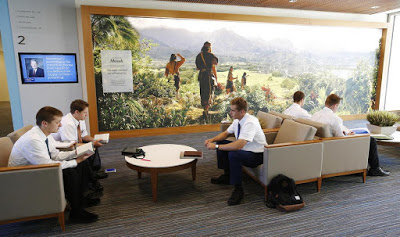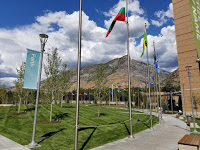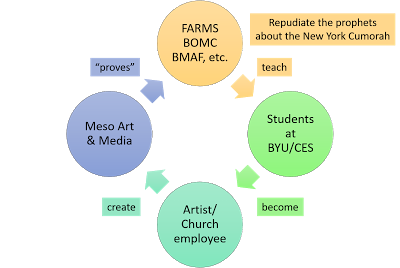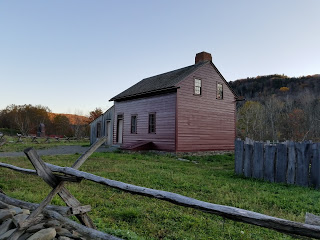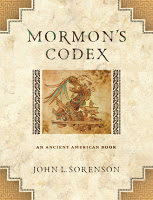Case study–Using art to prove Mesoamerican setting and failing the scholarship test
Here’s a prime example.
It’s based on the mural I posted yesterday, the one showing the “sons of Mosiah” approaching a Mayan pyramid city.
According to a blog post titled “Mesoamerican MTC Mural,” the message of the mural is repeated in several places at the MTC. “Multiple copies of this particular mural showing the four sons of Mosiah about to enter a Lamanite city are on display throughout the buildings.”
Here’s an image from that blog post:
 |
| Missionaries studying by mural depicting Mesoamerican/two-Cumorahs theory. Photo by LDS Church News! |
Continuing from the blog post: “The scene portrays the land of Nephi with stepped pyramids, in a tropical or sub-tropical setting with palm trees and low-latitude shrubs, beside a lake, surrounded by spectacular, densely-forested mountains…. Tropical Kaminaljuyú (KJ), our candidate for the city of Nephi, was built on Lake Miraflores and is surrounded by imposing, densely-forested volcanoes. See the article “Kaminaljuyu” for dozens of correspondences between KJ and the Book of Mormon text. These parallels are convincing enough that KJ is on our list of outstanding archaeological evidences.”
The blog post notes the promoters of the Mesoamerican/two-Cumorahs theory:
“All nine contemporary Mesoamerican correlations of which I am aware (Joe & Blake Allen, Ric Hauck & Joe Andersen, Kirk Magleby & Javier Tovar, Elder Clate W. Mask, Jr., Garth Norman, Bob Roylance & Richard Terry, Shelby Saberon & Mark Wright, John L. Sorenson, Aric Turner) place the city of Nephi within 85 air kilometers of Kaminaljuyú in the Guatemalan highlands.”
These intellectuals don’t even notice the deep irony of their internal confusion; i.e., they can’t agree even on their Mesoamerican/two-Cumorahs interpretation of the text. This is exactly the kind of confusion we expect when we reject the clear, consistent, and enduring teachings of the prophets and apostles about the New York Cumorah.
Then the post includes this map of Mesoamerica:
 |
| Proposed Locations for the City of Nephi |
So far as I know, this map hasn’t made it to the walls of the Provo MTC–yet. But it is implicit in all of these Mesoamerican murals, and every missionary knows that.
Especially if they’ve been taught the “abstract map” at BYU/CES, which depicts the Book of Mormon in a fantasy land designed to resemble Mesoamerica.
Here’s the most astonishing part of the blog post:
“It is gratifying to know that hundreds of thousands of missionaries entering the field in coming years will leave the MTC with a striking mental image derived from the best current LDS and Restoration Branch (formerly RLDS) scholarship on Book of Mormon lands…. Kudos to the Missionary Department.”
Think about that one for a moment.
These Mesoamerican/two-Cumorahs advocates feel “gratified” that their ideology is being actively promoted at the MTC–including their repudiation of what Joseph, Oliver, and all their contemporaries and successors have taught about the Hill Cumorah in New York.
If I had been responsible for promoting this ideology to the point that it is enshrined at the MTC, I would be working as hard as I could to undo the damage and instead reaffirm what the prophets and apostles have consistently and explicitly taught for over 150 years.
_____
There are two more elements of this that should be noted.
First, it was the RLDS (aka, “Restoration Branch”) who started the whole limited geography Mesoamerican/two-Cumorahs theory in the 1920s. At the time, Church historian and 20-year Apostle Joseph Fielding Smith denounced it. But LDS scholars ignored him and instead embraced the RLDS position.
Now, the RLDS are ambivalent about the Book of Mormon. Some still believe in its divine authenticity and actual historicity, but others do not.
At the 2007 Community of Christ World Conference, President Stephen M. Veazey ruled as out of order a resolution to “reaffirm the Book of Mormon as a divinely inspired record.” He said, “While the Church affirms the Book of Mormon as scripture, and makes it available for study and use in various languages, we do not attempt to mandate the degree of belief or use.”
BYU is following a similar pattern by first, repudiating what the prophets and apostles have consistently taught about Cumorah, and second, by requiring students to learn the Book of Mormon by using an “abstract map” (a euphemism for a fantasy map) that reinforces the repudiation of the prophets and apostles by depicting Cumorah in a Mesoamerican-type setting as far from New York as possible.
_____
The second point is the claim that the Mesoamerican/two-Cumorahs theory, depicted throughout the MTC, is “derived from the best current LDS and Restoration Branch (formerly RLDS) scholarship on Book of Mormon lands.”
There are actually groups from LDS and RLDS who regularly travel to southern Mexico in a quixotic search for Cumorah. It’s comical, really, but serious in the sense that these intellectuals are teaching not only BYU and CES students, but missionaries at the Provo MTC that the prophets and apostles are wrong.
But my favorite part of this is the claim that this is the “best current scholarship.”
Everyone knows that the Mormon Mesoamerican/two-Cumorahs advocates have painted themselves into a tiny corner.
Not only are they repudiating the prophets and apostles, but the best actual Mesoamerican scholarship uniformly rejects the Mormon claims. None of these Mormon intellectuals have managed to publish their theories in actual peer-reviewed journals.
BYU Studies and the Interpreter are peer-approved, not peer-reviewed. They don’t seek or accept input from scholars who don’t already share their ideology. (I’ve had some of them tell me they are “diverse” because of the disagreements about details such as where in Guatemala the City of Nephi is located, as alluded to in the quotation above. That’s the extent of the “diversity of views” they allow.)
In fact, I know one actual Mesoamerican scholar who has written textbooks on the topic and who left the Church because he realized there was no possible connection between Mesoamerican history/culture and the Book of Mormon.
I’ve said for years that the “correspondences” between the actual Mayan civilization and the Book of Mormon are illusory. The idea that Lehi’s colony was completely absorbed into a massive Mayan culture is preposterous on its face, without even considering all the textual reasons why that would be impossible. That’s why these intellectuals have to use their own translation of the text (by “seeing” volcanoes, pyramids, tapirs, and other things Joseph forgot to translate correctly) to make their theories work.
IOW, the “best current LDS scholarship on Book of Mormon lands” is a joke to actual Mesoamerican scholars.
As it should be, given that this “scholarship” is nothing more than a repudiation of the prophets and apostles who have consistently taught that Cumorah is in New York.
Source: Book of Mormon Wars
